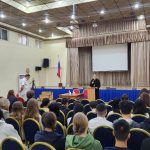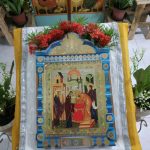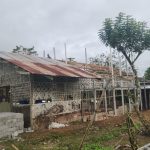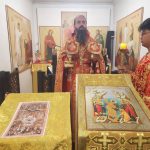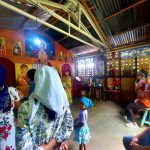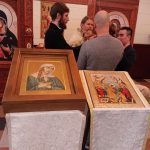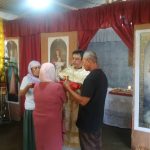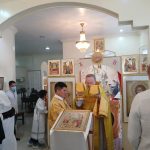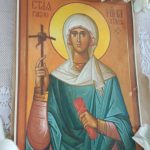
Features of the Orthodox mission in the Philippines.
In 2015, TV channels showed more than 200 Filipinos being baptized in the waters of the Pacific Ocean and taking communion just on the shore during the Divine Liturgy for the first time. It was not the first mass baptism of the inhabitants of the island state.
The Philippines is the only country in Southeast Asia where the majority of the population are Christians (mostly Catholics). ln recent years there are more Orthodox Christians here. In December 2018, the parishes of the Moscow Patriarchate in the Philippines were incorporated into the Patriarchal Exarchate in Southeast Asia. ln February 2019, the Philippine-Vietnamese Diocese was established within the exarchate.
Hieromonk Korniliy (Molev), the secretary of the Diocese, cleric of the Blessed Matrona of Moscow parish in Davao City and head of the educational center of the same name, tells the Journal of the Moscow Patriarchate about the peculiarities of the mission in the Philippines.
The example of Father Daniel.
Father Korniliy begins his story from afar, when he studied at the Moscow Institute of Engineering and Physics. Near the dormitory he lived, there was the church of St Apostle Thomas on Kantemirovskaya street, where Fr Daniel Sysoev served as rector. The young man began to attend this church and entered the missionary school of Fr Daniel.
— After the murder of Father Daniel in 2009, we began to look at his ministry with different eyes, including as a missionary, – Fr Korniliy recalls. — It became clear that this was not just a good priest and theologian, but a man who suffered for his preaching – for Christ. And it became impossible to leave the work started by Father Daniel. I still teach at the school he created. Today it is called the Orthodox Missionary School at the Synodal Missionary Department. While studying there and being still a layman, I took part in several missionary trips to Africa, Mongolia, Cambodia, then to the Philippines, when our priests just started coming there. After graduating from my college, I continued my studies at the Belgorod missionary seminary. Its rector at that time was Metropolitan John of Belgorod, who also headed the Synodal missionary Department. He took me to study with him in 2013, because I wanted to go abroad after graduating from the seminary (I already had an invitation to carry out obedience in Cambodia and Laos).
While I was studying in Moscow and Belgorod, the Church in Asia has grown significantly. The parishes of the Moscow Patriarchate in Cambodia and the Philippines were under the care of Archbishop Sergiy (Chashin) of Solnechnogorsk (now Metropolitan of Singapore and Southeast Asia, Patriarchal Exarch of Southeast Asia). I began to serve in Cambodia, and then Vladyka transferred me to the Philippines, as there was a much greater need for priests there. Now for 3 years I have been serving on the island of Mindanao, the second largest island in the south of the country.
A shelter for Russian refugees.
The first Orthodox community in 1923 in Manila (the capital of the Philippines) was formed by emigrants from Russia. In 1934, on the basis of the appeal of the Russian diaspora in Manila, Bishop Victor (Svyatin) of China and Beijing established a parish in honor of the Iveron Icon of the Mother of God. The Iveron temple existed until 1945, when it was destroyed during the liberation of the city from the Japanese invaders.
In 1949, after the Communists came to power in China, about six thousand Russian refugees left Shanghai. Of all the countries, only the Republic of the Philippines has agreed to temporarily accept them. The Russians were stationed on the small island of Tubabao. Among the first, two churches were built: in honor of the Archangel Michael and Seraphim of Sarov. The Holy Mother of God Cathedral was built from the former military marching church. Among the refugees was Bishop John (Maksimovich), the future St. John of Shanghai. He periodically traveled from the Philippines to other countries, primarily to the USA, to organize the relocation of refugees there. And he succeeded: in 1951, the Russians mostly left the Philippines.
A big interest in the Russian Orthodox Church began in 2013. This year, typhoon Haiyan, terrible in its destructiveness, occurred, having killed several thousand people. Fr Kirill Shkarbul, a priest of the Russian Orthodox Church, was one of the first to arrive with humanitarian aid from Taiwan to Tubabao Island. Communicating with him, the locals became interested in Orthodoxy, thought about baptism, invited him to visit them more often. Since Fr Kirill is serving in Taiwan, he began to look for missionaries and priests who could come to the Philippines and talk about the Orthodox faith. One of the first to respond was the priest Georgy Maximov. He and Father Kirill performed the first mass baptisms.
In October 2016, the Holy Synod appointed Bishop Sergiy (Chashin) of Solnechnogorsk as the Administrator of the parishes of the Moscow Patriarchate in Vietnam, the Philippines, Singapore, Indonesia, Malaysia, Cambodia, Laos, the DPRK and the Republic of Korea. His Eminence began his activity with restoring the Iveron parish in Manila on Easter in April 2017. This parish has united Orthodox people of many nationalities, and its backbone became the Orthodox Filipinos interested in Russian culture. With the appointment of Bishop Sergiy, the priest Stanislav Rasputin came to the Philippines to work.
In December 2018, by the decision of the Holy Synod of the Russian Orthodox Church, the Patriarchal Exarchate of Southeast Asia was formed with 4 dioceses: Korean, Singapore, Thailand and Philippine-Vietnamese. Metropolitan Sergiy was appointed head of the Exarchate.
The mission proceeds from below
— You served in Cambodia, now you serve in the Philippines. What are the main differences in the perception of religion in these countries? I ask Fr Korniliy.Cambodia is a Buddhist country, the Philippines is Catholic. Filipinos have a Christian worldview. They sincerely believe in God. You can see, for example, a tricycle driver (a local public transport – a motorcycle with a sidecar, where people are transported), who will cross himself before the road. When there was an earthquake, people ran out into the street and shouted: “God save us!”
ln Cambodia, Buddhist culture is widespread. People have no idea of the One God there, it is simply washed away by this Buddhist worldview. There are spirits being fed on every corner. There are special houses everywhere where Cambodians leave food for them. You won’t find this in the Philippines. There are some occultists and shamans here but, in general, people have a Christian understanding of the world.
Speaking about the specifics of the mission in the Philippines, my interlocutor emphasizes that this is not a “classic” version of enlightenment, when missionaries come to a new land and preach, then people study the basics of faith to be baptized. Here the mission goes “from below”. Local residents themselves learn about Orthodoxy from books, through the Internet and ask for baptism.
The difficulty lies in the fact, explains Fr Korniliy, that not one or two people come to Orthodoxy here, but often whole communities. So, for example, in 2015, four communities of Aglipay church were baptized at once. Those were representatives of the Independent Philippine Church, which originated in the early twentieth century and bears the name of its founder Gregorio Aglipay, a Catholic priest who, protesting against the colonial policy of the Catholic Church, went into schism. Over time, the Aglipay people began to have a crisis of faith. They saw that each of the communities believes in something different. And they began to search the true faith. They learned that there are Russian priests in the Philippines, and invited them to talk about Christ. The process of catechization has begun. As a result, these communities were accepted into the Russian Orthodox Church: thousands of people who needed to be taught our faith. They had their own church culture, but it is far from ours. It helps that they are ready to change, to learn, they really like it. There is a large amount of work here, and there are not enough personnel. This is similar to our nineties, when people went to Church en masse and had to be received and instructed, but there were not enough priests.
Study for priests and parishioners.
Fr Korniliy notes that when the Synod appointed Bishop Sergiy to serve in the countries of Southeast Asia, it became a new level of organization of the work. A diocese was formed, 5 deaneries appeared: Manila (Luzon and Cebu Islands), Davao (Mindanao and Leyte), General Santos, Davao del Sur and Vietnamese. Diocesan departments were formed: missionary, social and catechetical. A full-fledged diocese has developed.
There is a personnel shortage, a lot of problems, but now the work is more focused and we have a lot to grow.
In August 2019, by the decision of the Holy Synod, Metropolitan Pavel (Fokin) of Khanty-Mansiysk and Surgut with the title “Metropolitan of Manila and Hanoi” was entrusted to be the ruling bishop of the Philippine-Vietnamese diocese. It was just recently the 10th anniversary of the Khanty-Mansiysk diocese in which he serves. He has extensive experience in organizing diocesan life. And he brought this experience to the Philippines. It is very symbolic that Vladyka Pavel served as a priest in the cathedral in honor of the Icon of the Mother of God “Joy of All who Sorrow” in San Francisco, where the relics of St. John of Shanghai rest. In 1949-1951, during the 27-month period of stay of Russian refugees on the island of Tababao, St. John walked around the entire camp every night and made the sign of the cross on all four sides. No typhoon happened during that period. After the people left for different countries, a terrible typhoon hit and destroyed the camp to the ground. And now St. John has brought Vladyka Pavel to work in the Philippines. We believe that this is not a simple coincidence.
After thousands of inhabitants of the archipelago converted to Orthodoxy, they had to be taught somewhere. That is why the Blessed Matrona of Moscow Educational Center in Davao was founded, headed by Fr Korniliy. Classes are held here for singers, elders of communities, future mothers. Educational activities are conducted among parishioners. Knowledge is given in a variety of fields – from the study of the rules of worship, including the performance of services by a lay rank and choir singing, to the subtleties of baking prosphora and sewing church vestments.
-At first, the center was organized in the city of General Santos, but not all priests could work there permanently. And it was not really a center but, rather, a base. When Vladyka Sergiy was appointed, he established a missionary center in Davao – the island’s capital and the third city of the Philippines. Here Filipinos can receive basic knowledge to go then to Russia to study in seminaries and theological academies. Before going to Russia, they need to undergo some training here, where the situation is close to the seminar realities. It is important that they in advance take an experience of the routine of the educational institution.
The first ordinations were performed by Vladyka Sergiy. For the first time, five Filipino people were ordained deacons at once and then one became a priest. Then Vladyka Pavel ordained two deacons as presbyters. In February 2020, during his archpastoral visit to the Philippines, Metropolitan Pavel ordained 5 elders of the church communities of the island of Mindanao as deacons. They are also trained in our center.
Bamboo temple.
I ask Fr Korniliy, what Orthodox churches in the Philippines look like. The priest says that in Davao, where he serves, it is a rented house, which doesn’t look like temple from the outside. In rural areas, these are mainly bamboo buildings with an earthen floor. Inside it is more recognizable – the iconostasis, candlestands.
Our Church managed to build three buildings of temple architecture. One of them was badly damaged due to an earthquake a year and a half ago, and is now recovering. The construction of another temple is ongoing. On February 22, 2020, for the first time in the history of the Russian Orthodox Church in the Philippines, Metropolitan Pavel consecrated with a Great Rite the church in honor of St Seraphim of Sarov in Makalangot. Soon after that, many icons in this temple began to stream the myrrh.
There are 31 Orthodox parishes in the Philippines and 13 clerics.
The main work of our Diocese is to translate Orthodox prayer books and liturgical texts into Cebuano and Tagalog (the most common languages here). The texts of the services for the main feasts have already been translated. Orthodox Filipinos can celebrate the Liturgy in their native languages.
Fr Korniliy says that Filipinos adopt the traditions of the celebration of the feast of feasts – Easter – from the Russian Orthodox. Long fasts are new to Filipinos, but they try to observe them. Night services inspire them amazingly. But the peculiarities of the national cuisine are reflected on their Easter table.
The locals tried the Easter cakes, and they did not like them much, because Filipinos rarely eat bread. They did not find the cake as sweet as they like, for them it is almost tasteless. But when a local resident cooked Easter cakes according to a Russian recipe but putting five times more sugar in there, they became, in their opinion, already more edible. They like to eat sweet rice — this is a joy for Filipinos.
For locals, the main dish of any festive table, including Easter, is lechon – a whole piglet baked. They don’t eat meat often at normal times, because most of them live in poverty and can’t afford it. Therefore, cooking a pig is a great holiday. The meat is baked on a spit, on a fire, without spices (because they are expensive) and it turns out inside as boiled. To our taste, this dish is not very appetizing. But these are particulars. The main thing is that we have the same taste for Church and Truth. And the essence of the holiday remains the service in the temple and the Easter joy, which overwhelms Filipinos just as much as Russian believers.
Elena ALEKSEEVA

